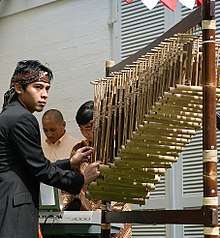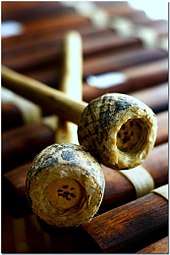Angklung
The angklung (Sundanese: ᮃᮀᮊᮣᮥᮀ) is a musical instrument from West Java, Indonesia made of a varying number of bamboo tubes attached to a bamboo frame. The tubes are carved to have a resonant pitch when struck and are tuned to octaves, similar to Western handbells. The base of the frame is held in one hand, while the other hand shakes the instrument, causing a repeating note to sound. Each performer in an angklung ensemble is typically responsible for just one pitch, sounding their individual angklung at the appropriate times to produce complete melodies (see Kotekan).
 Angklung with eight pitches | |
| Percussion instrument | |
|---|---|
| Classification | Idiophone |
| Hornbostel–Sachs classification | 111.232 (Sets of percussion tubes) |
| Developed | Indonesia |
| Indonesian Angklung | |
|---|---|
 | |
| Country | Indonesia |
| Reference | 393 |
| Region | Asia and the Pacific |
| Inscription history | |
| Inscription | 2010 (5th session) |
| List | Representative |
| Music of Indonesia | |
|---|---|
 Kempul gongs from Java | |
| Genres | |
| |
| Specific forms | |
| Regional music | |
The angklung is popular throughout the world, but it originated in what is now West Java and Banten provinces in Indonesia, and has been played by the Sundanese for many centuries. The angklung and its music have become an important part of the cultural identity of Sundanese communities in West Java and Banten.[1] Playing the angklung as an orchestra requires cooperation and coordination, and is believed to promote the values of teamwork, mutual respect and social harmony.[2]
On November 18, 2010, UNESCO officially recognized the Indonesian angklung as a Masterpiece of the Oral and Intangible Heritage of Humanity, and encouraged the Indonesian people and the Indonesian government to safeguard, transmit, promote performances and to encourage the craftsmanship of the angklung.[2]
Etymology
The word angklung may have originated from Sundanese "angkleung-angkleungan", suggesting the movement of the angklung player and the "klung" sound that comes from the instrument.[3]
Another theory suggests that the word angklung was formed from two Balinese words – angka and lung. Angka means "tone", and lung means "broken" or "lost". Angklung thus means "incomplete tone".[3]
History

According to Dr. Groneman, the angklung had already been a favorite musical instrument of the entire archipelago even before the Hindu era. According to Jaap Kunst in Music in Java, besides West Java, angklung also exists in South Sumatra and Kalimantan. Lampung, East Java and Central Java are also familiar with the instrument.[3]
In the Hindu period and the time of the Kingdom of Sunda, the instrument played an important role in ceremonies. The angklung was played to honor Dewi Sri, the goddess of fertility, so she would bless their land and lives.[4] The angklung also signaled the time for prayers, and was said to have been played since the 7th century in the Kingdom of Sunda. In the Kingdom of Sunda, it provided martial music during the Battle of Bubat, as told in the Kidung Sunda.[5] The oldest surviving angklung is the Angklung Gubrag, made in the 17th century in Jasinga, Bogor. Other antique angklung are stored in the Sri Baduga Museum, Bandung.[5] The oldest angklung tradition is called angklung buhun (Sundanese: "ancient angklung") from Lebak Regency, Banten.[6] The angklung buhun is an ancient type of angklung played by Baduy people of the inland Banten province during the seren taun harvest ceremony.
In 1938, Daeng Soetigna [Sutigna], from Bandung, created an angklung that is based on the diatonic scale instead of the traditional pélog or sléndro scales. Since then, the angklung has returned to popularity and is used for education and entertainment, and may even accompany Western instruments in an orchestra. One of the first performances of angklung in an orchestra was in 1955 during the Bandung Conference. In 1966 Udjo Ngalagena, a student of Daeng Soetigna, opened his Saung Angklung ("House of Angklung") as a centre for its preservation and development.[5]
UNESCO designated the angklung a Masterpiece of the Oral and Intangible Heritage of Humanity on November 18, 2010.[7]
Balinese gamelan angklung
%2C_2015-05-21.jpg)
In Bali, an ensemble of angklung is called a gamelan angklung. While the ensemble gets its name from the bamboo shakers, they are nowadays rarely included outside of East Bali. An ensemble of mostly bronze metallophones is used instead, generally with about 20 musicians.
While the instrumentation of the gamelan angklung is similar to gamelan gong kebyar, there are several critical differences. The instruments in the gamelan angklung are tuned to a 5-tone slendro scale, although most ensembles use a four-tone mode of the five-tone scale played on instruments with four keys. An exception is the five-tone angklung from the north of Bali, which may have as many as seven keys.[8] In four-tone angklung groups, the flute players will occasionally use an implied fifth tone. Additionally, whereas many of the instruments in gong kebyar span multiple octaves of its pentatonic scale, most gamelan angklung instruments only contain one octave, although some five-tone ensembles have roughly an octave and a half. The instruments are considerably smaller than those of the gong kebyar.
Gamelan angklung is heard in Balinese temples, where it supplies musical accompaniment to temple anniversaries (odalan). It is also characteristic of rituals related to death (pitra yadnya), and is therefore connected in Balinese culture to the invisible spiritual realm and transitions from life to death and beyond. Because of their portability, gamelan angklung instruments may be carried in processions while a funeral bier is carried from temporary burial in a cemetery to the cremation site. The musicians also often play music to accompany the cremation ceremony. Thus, many Balinese listeners associate angklung music and its slendro scale with strong emotions evoking a combination of sacred sweetness and sadness.
The structure of the music is similar to gong kebyar, although employing a four-tone scale. A pair of jegog metallophones carries the basic melody, which is elaborated by gangsa, reyong, ceng-ceng, flute, and small drums played with mallets. A medium-sized gong, called kempur, is generally used to punctuate a piece's major sections.
Most older compositions do not employ gong kebyar's more ostentatious virtuosity and showmanship. Recently, many Balinese composers have created kebyar-style works for gamelan angklung or have rearranged kebyar melodies to fit the angklung's more restricted four-tone scale. These new pieces often feature dance, so the gamelan angklung is augmented with heavier gongs and larger drums. Additionally, some modern composers have created experimental instrumental pieces for the gamelan angklung.
Outside Indonesia

The angklung was first invented in West Java, Indonesia, with a possibility of cultural transmittance to various other places such as Malaysia and the Philippines over the course of several centuries. In the early 20th century during the time of the Dutch East Indies, the angklung was adopted in Thailand, where it is called angkalung (อังกะลุง). It was recorded that angklung was brought to Siam in 1908 by Luang Pradit Pairoh, a royal musician in the entourage of Field Marshal Prince Bhanurangsi Savangwongse of Siam, who paid a royal visit to Java that year (27 years after the first state visit of his elder brother, King Chulalongkorn, to Java in 1871). The Thai angklung are typically tuned in the Thai tuning system of seven equidistant steps per octave, and each angklung has three bamboo tubes tuned in three separate octaves rather than two, as is typical in Indonesia.
In 2008, there was a grand celebration in the Thai traditional music circle to mark the 100th anniversary of the introduction of angklung to Thailand. Both the Thai and Indonesian governments supported the celebration.
The angklung has also been adopted by its Austronesian-speaking neighbors, in particular by Malaysia and the Philippines, where they are played as part of bamboo xylophone orchestras. Formally introduced into Malaysia sometime after the end of the Confrontation, angklung found immediate popularity.[9] They are generally played using a pentatonic scale similar to the Indonesian slendro, although in the Philippines, sets also come in the diatonic and minor scales used to perform various Spanish-influenced folk music in addition to native songs in pentatonic.
At least one Sundanese angklung buncis ensemble exists in the United States. Angklung Buncis Sukahejo is an ensemble at The Evergreen State College, and includes eighteen double rattles (nine tuned pairs) and four dog-dog drums.
World record
On July 9, 2011, 5,182 people from many nations played angklung together in Washington, D.C., and are listed in the Guinness Book of Records as the largest angklung ensemble.[10]
See also
References
- Spiller, Henry (2004). Gamelan: The Traditional Sounds of Indonesia, Volume 1. ABC-CLIO. p. 140. ISBN 9781851095063.
Angklung has become a veritable symbol of Sundanese culture
- ""Indonesian Angklung", Inscribed in 2010 (5.COM) on the Representative List of the Intangible Cultural Heritage of Humanity". UNESCO. Retrieved 10 October 2014.
- "Angklung : Harmony in a Bamboo Orchestra". Archived from the original on 28 September 2014. Retrieved 2 October 2014.
- "Banten Angklung Buhun". Archived from the original on 2011-10-03. Retrieved 2011-08-19.
- Awi-Awi Mandiri, The Spirit of Angklung, 2018
- Kesenian Angklung Buhun Archived October 2, 2011, at the Wayback Machine
- "Unesco to Declare Indonesia's Angklung World Heritage". The Jakarta Globe. October 8, 2018.
- Ornstein, Ruby (1971). "The Five-Tone Gamelan Angklung of North Bali". Ethnomusicology. 15 (1): 71–80. doi:10.2307/850388. JSTOR 850388.
- Koh, Lay Tin (17 April 1999). "Angklung". National Library Board Singapore. Archived from the original on 14 October 2008. Retrieved 2 September 2009.
- Bayuni, Endy M. (July 10, 2011). "Washington DC shakes to angklung world record". The Jakarta Post. Archived from the original on July 12, 2011. Retrieved July 11, 2011.
Further reading
- Tenzer, Michael (1998). Balinese Music. Hong Kong: Periplus Eds. ISBN 9789625931692.
External links
| Wikimedia Commons has media related to Angklung. |
- Gamelan Sekar Jaya (excerpt about angklung) from Michael Tenzer's book Balinese Music
- Musical sample composed by I Nyoman Windha
- Saung Angklung Udjo
- Angklung Orchester Hamburg, Germany (2003/2004)
- Angklung Web Institute
- Lancaster Angklung Orchestra, Lancaster, UK
- Angklung Hamburg
- Keluarga Paduan Angklung SMA Negeri 3 Bandung



